Accounting Skills Report: Financial Analysis and Budgeting Techniques
VerifiedAdded on 2021/01/01
|15
|3508
|337
Report
AI Summary
This report provides a detailed analysis of various accounting concepts and techniques. It begins with the preparation of financial statements, including an income statement and balance sheet for Fort Road Foxtrot, followed by a discussion of the differences between financial and management acco...
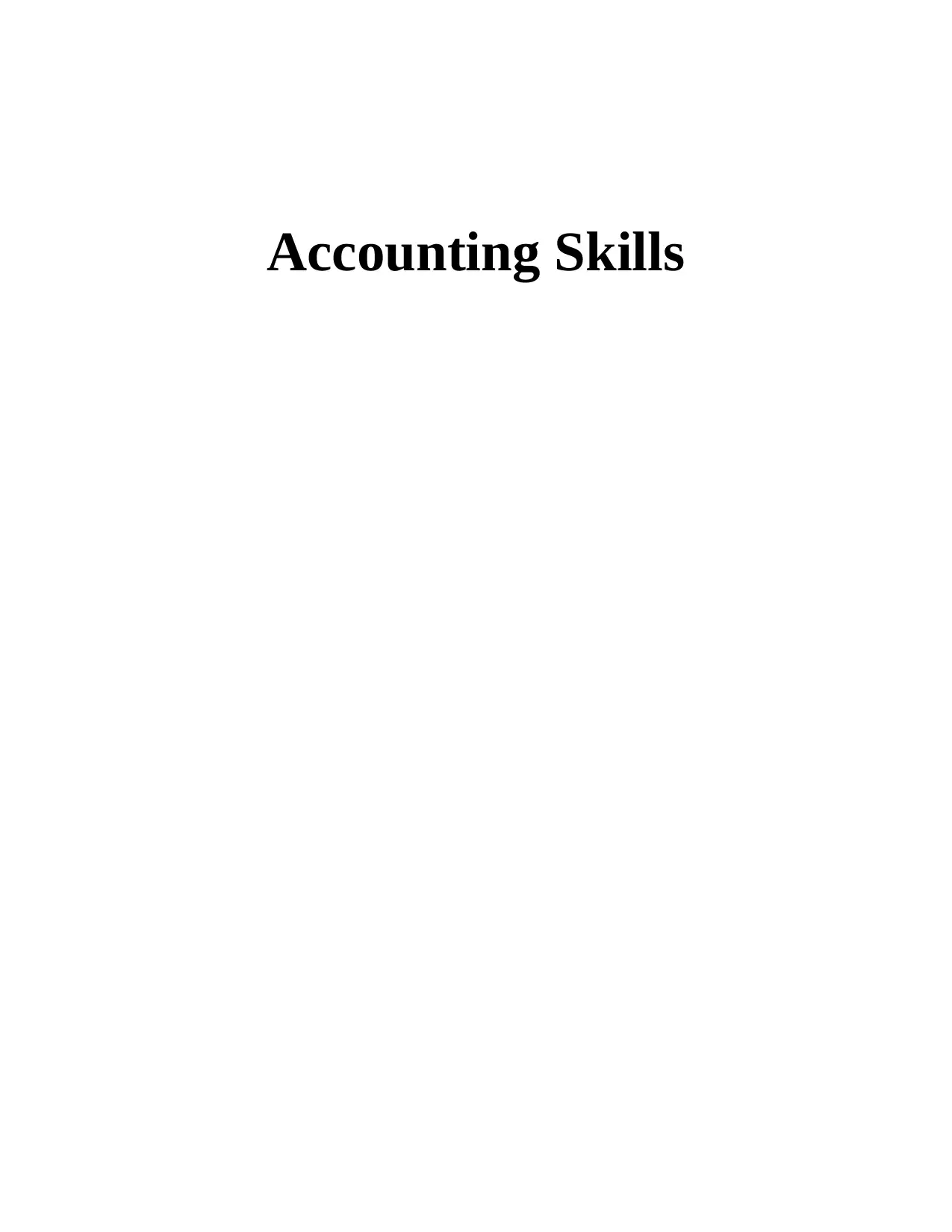
Accounting Skills
Paraphrase This Document
Need a fresh take? Get an instant paraphrase of this document with our AI Paraphraser
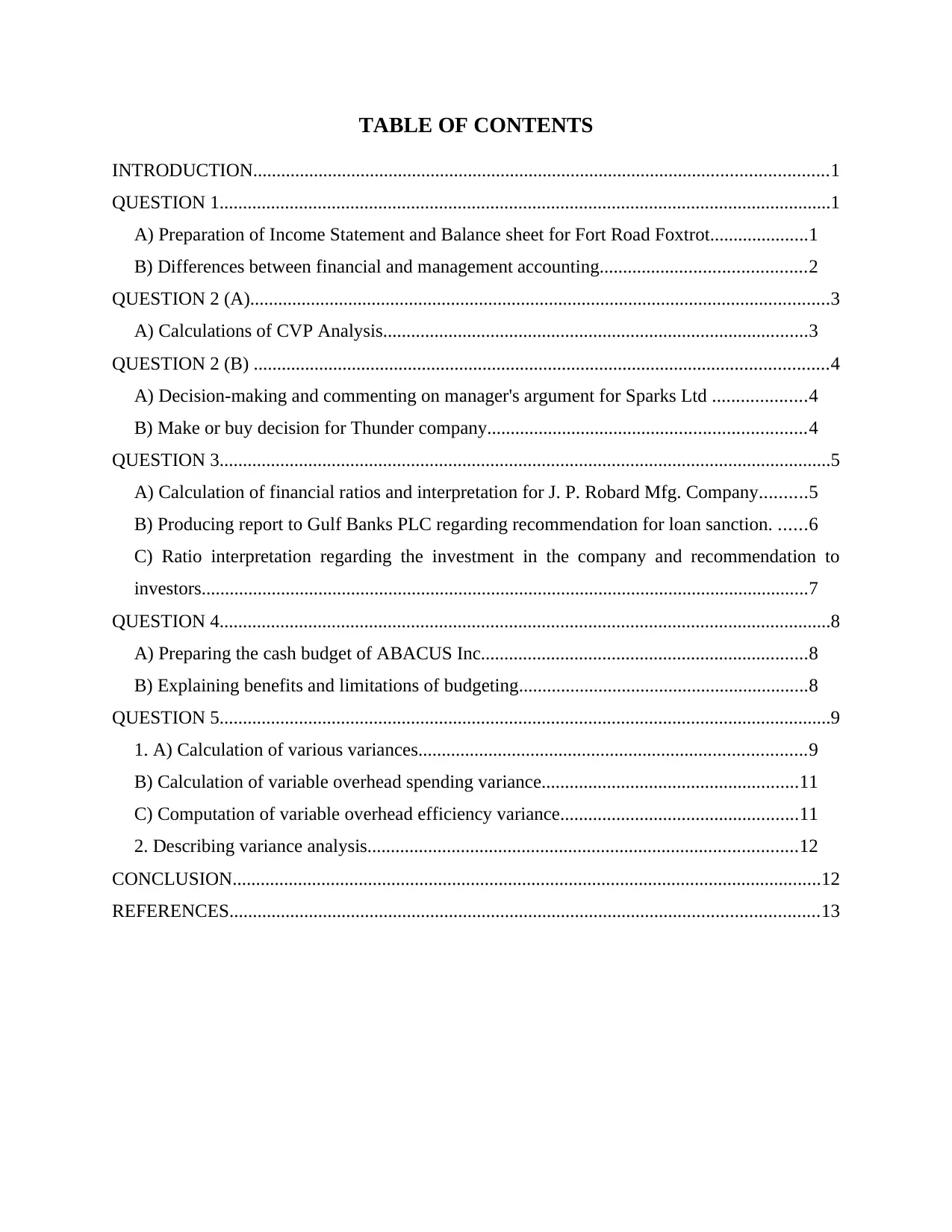
TABLE OF CONTENTS
INTRODUCTION...........................................................................................................................1
QUESTION 1...................................................................................................................................1
A) Preparation of Income Statement and Balance sheet for Fort Road Foxtrot.....................1
B) Differences between financial and management accounting............................................2
QUESTION 2 (A)............................................................................................................................3
A) Calculations of CVP Analysis...........................................................................................3
QUESTION 2 (B) ...........................................................................................................................4
A) Decision-making and commenting on manager's argument for Sparks Ltd ....................4
B) Make or buy decision for Thunder company....................................................................4
QUESTION 3...................................................................................................................................5
A) Calculation of financial ratios and interpretation for J. P. Robard Mfg. Company..........5
B) Producing report to Gulf Banks PLC regarding recommendation for loan sanction. ......6
C) Ratio interpretation regarding the investment in the company and recommendation to
investors..................................................................................................................................7
QUESTION 4...................................................................................................................................8
A) Preparing the cash budget of ABACUS Inc......................................................................8
B) Explaining benefits and limitations of budgeting..............................................................8
QUESTION 5...................................................................................................................................9
1. A) Calculation of various variances...................................................................................9
B) Calculation of variable overhead spending variance.......................................................11
C) Computation of variable overhead efficiency variance...................................................11
2. Describing variance analysis............................................................................................12
CONCLUSION..............................................................................................................................12
REFERENCES..............................................................................................................................13
INTRODUCTION...........................................................................................................................1
QUESTION 1...................................................................................................................................1
A) Preparation of Income Statement and Balance sheet for Fort Road Foxtrot.....................1
B) Differences between financial and management accounting............................................2
QUESTION 2 (A)............................................................................................................................3
A) Calculations of CVP Analysis...........................................................................................3
QUESTION 2 (B) ...........................................................................................................................4
A) Decision-making and commenting on manager's argument for Sparks Ltd ....................4
B) Make or buy decision for Thunder company....................................................................4
QUESTION 3...................................................................................................................................5
A) Calculation of financial ratios and interpretation for J. P. Robard Mfg. Company..........5
B) Producing report to Gulf Banks PLC regarding recommendation for loan sanction. ......6
C) Ratio interpretation regarding the investment in the company and recommendation to
investors..................................................................................................................................7
QUESTION 4...................................................................................................................................8
A) Preparing the cash budget of ABACUS Inc......................................................................8
B) Explaining benefits and limitations of budgeting..............................................................8
QUESTION 5...................................................................................................................................9
1. A) Calculation of various variances...................................................................................9
B) Calculation of variable overhead spending variance.......................................................11
C) Computation of variable overhead efficiency variance...................................................11
2. Describing variance analysis............................................................................................12
CONCLUSION..............................................................................................................................12
REFERENCES..............................................................................................................................13

INTRODUCTION
Accounting is an integral part of the company directing towards assessing business
operations in financial terms so that proper records could be kept and financial statements may
be prepared. Present report deals with various scenarios where financials are produced from
adjusted trial balance. CVP analysis is conducted, financial ratios have been calculated.
Moreover, cash budget is prepared and advantages and limitations of budgeting is done.
Furthermore, variance analysis is devised and accounting is done.
QUESTION 1
A) Preparation of Income Statement and Balance sheet for Fort Road Foxtrot
Income Statement
Particulars Figures
Net sales 12,800
Less: Cost of goods sold 5,750
Gross profit 7,050
Less: Operating expenses 1,350
Less: depreciation expense 1,200
Operating profit 4,500
Less: interest expense 900
Earnings after interest and before
taxation 3600
Less: Taxes 1440
Earnings after taxation or net
profit 2160
Balance sheet
Particulars Figures (In $)
Inventory $6,500
Cash 16,550
1
Accounting is an integral part of the company directing towards assessing business
operations in financial terms so that proper records could be kept and financial statements may
be prepared. Present report deals with various scenarios where financials are produced from
adjusted trial balance. CVP analysis is conducted, financial ratios have been calculated.
Moreover, cash budget is prepared and advantages and limitations of budgeting is done.
Furthermore, variance analysis is devised and accounting is done.
QUESTION 1
A) Preparation of Income Statement and Balance sheet for Fort Road Foxtrot
Income Statement
Particulars Figures
Net sales 12,800
Less: Cost of goods sold 5,750
Gross profit 7,050
Less: Operating expenses 1,350
Less: depreciation expense 1,200
Operating profit 4,500
Less: interest expense 900
Earnings after interest and before
taxation 3600
Less: Taxes 1440
Earnings after taxation or net
profit 2160
Balance sheet
Particulars Figures (In $)
Inventory $6,500
Cash 16,550
1
⊘ This is a preview!⊘
Do you want full access?
Subscribe today to unlock all pages.

Trusted by 1+ million students worldwide
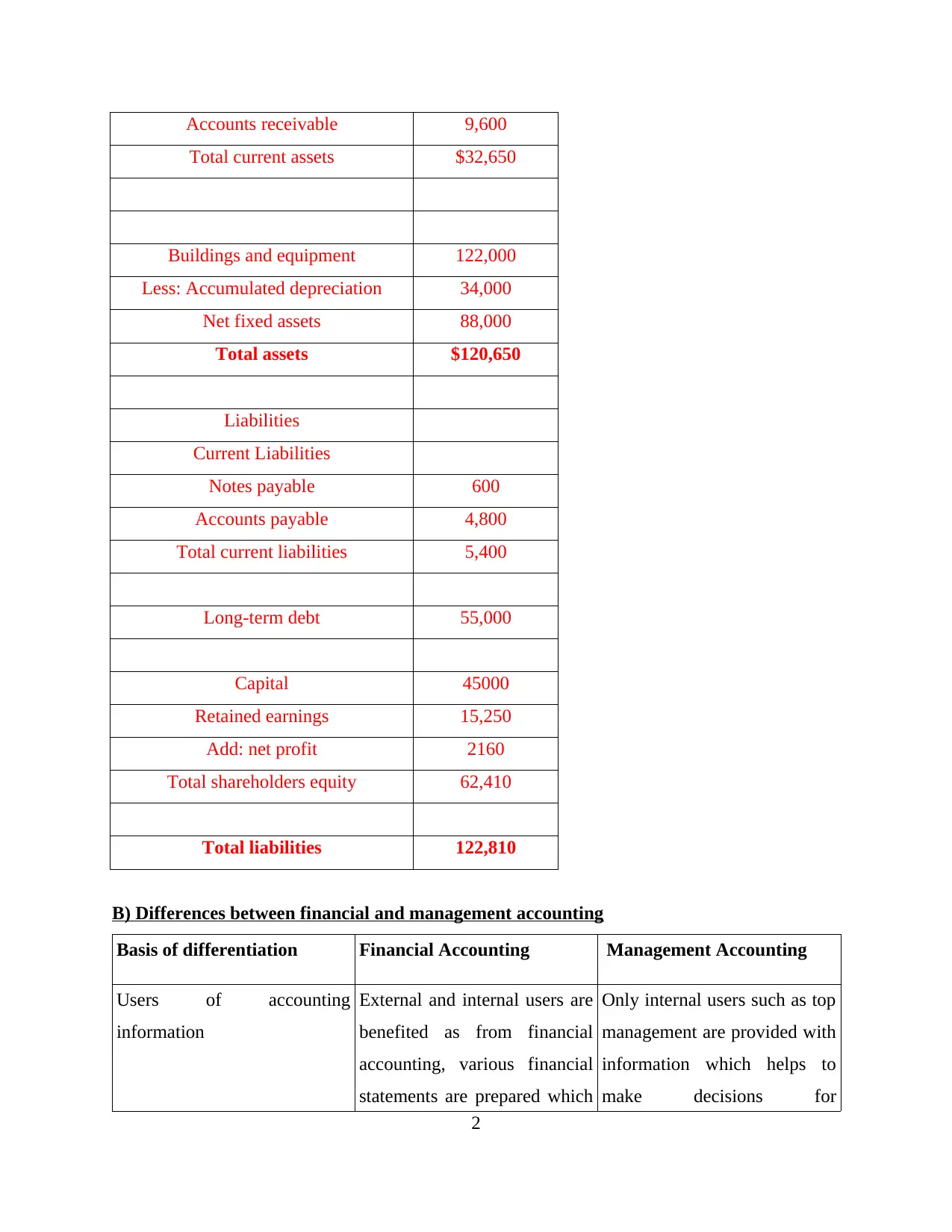
Accounts receivable 9,600
Total current assets $32,650
Buildings and equipment 122,000
Less: Accumulated depreciation 34,000
Net fixed assets 88,000
Total assets $120,650
Liabilities
Current Liabilities
Notes payable 600
Accounts payable 4,800
Total current liabilities 5,400
Long-term debt 55,000
Capital 45000
Retained earnings 15,250
Add: net profit 2160
Total shareholders equity 62,410
Total liabilities 122,810
B) Differences between financial and management accounting
Basis of differentiation Financial Accounting Management Accounting
Users of accounting
information
External and internal users are
benefited as from financial
accounting, various financial
statements are prepared which
Only internal users such as top
management are provided with
information which helps to
make decisions for
2
Total current assets $32,650
Buildings and equipment 122,000
Less: Accumulated depreciation 34,000
Net fixed assets 88,000
Total assets $120,650
Liabilities
Current Liabilities
Notes payable 600
Accounts payable 4,800
Total current liabilities 5,400
Long-term debt 55,000
Capital 45000
Retained earnings 15,250
Add: net profit 2160
Total shareholders equity 62,410
Total liabilities 122,810
B) Differences between financial and management accounting
Basis of differentiation Financial Accounting Management Accounting
Users of accounting
information
External and internal users are
benefited as from financial
accounting, various financial
statements are prepared which
Only internal users such as top
management are provided with
information which helps to
make decisions for
2
Paraphrase This Document
Need a fresh take? Get an instant paraphrase of this document with our AI Paraphraser

are used to assess profitability
position of company (Bragg.
2017).
strengthening internal
operations.
Time of preparation There is fixed time period
usually, it is prepared at the
end of accounting period be it
calendar year or financial year.
Managerial reports are
prepared without following
any particular year and are
produced frequently when
management deems fit for the
same.
Valuation principle Financial accounting quite
effectively addresses value of
assets and liabilities and
revaluation and impairments
takes place.
However, no valuation is made
only, it is used to measure
productivity of these
instruments whether they are
productive or not.
Accounting Standards Financial statements prepared
must follow accounting
standards so as to provide
better information to the
external parties connected with
organisation (Hilton and Platt,
2013).
No accounting standards are
followed by management
accounting and as a result, it
does not comply with it.
Information Firm provides a summarised
information regarding
financial health of it to all
stakeholders.
On the other hand, detail
information with regards to
product, line of product and
geographic information.
3
position of company (Bragg.
2017).
strengthening internal
operations.
Time of preparation There is fixed time period
usually, it is prepared at the
end of accounting period be it
calendar year or financial year.
Managerial reports are
prepared without following
any particular year and are
produced frequently when
management deems fit for the
same.
Valuation principle Financial accounting quite
effectively addresses value of
assets and liabilities and
revaluation and impairments
takes place.
However, no valuation is made
only, it is used to measure
productivity of these
instruments whether they are
productive or not.
Accounting Standards Financial statements prepared
must follow accounting
standards so as to provide
better information to the
external parties connected with
organisation (Hilton and Platt,
2013).
No accounting standards are
followed by management
accounting and as a result, it
does not comply with it.
Information Firm provides a summarised
information regarding
financial health of it to all
stakeholders.
On the other hand, detail
information with regards to
product, line of product and
geographic information.
3
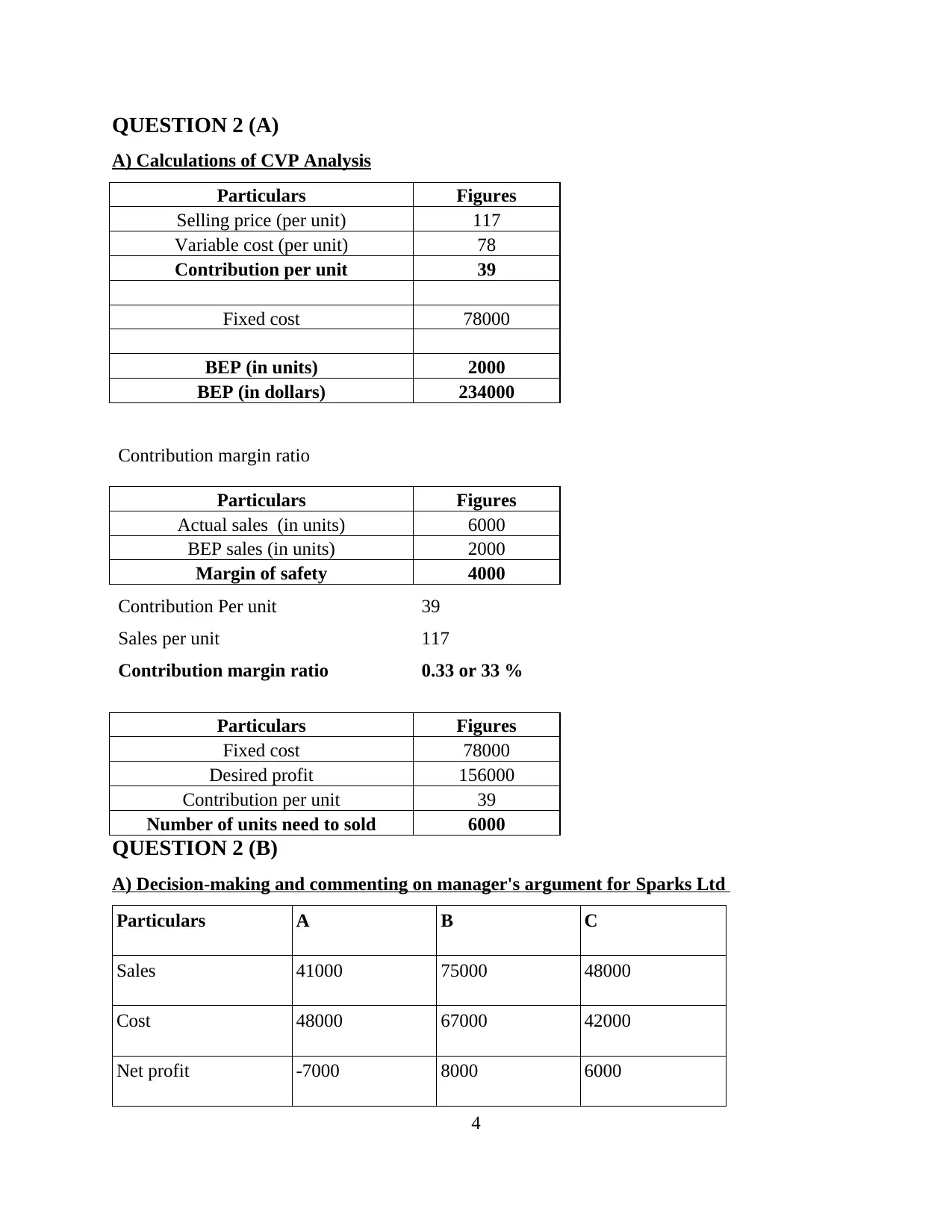
QUESTION 2 (A)
A) Calculations of CVP Analysis
Particulars Figures
Selling price (per unit) 117
Variable cost (per unit) 78
Contribution per unit 39
Fixed cost 78000
BEP (in units) 2000
BEP (in dollars) 234000
Contribution margin ratio
Particulars Figures
Actual sales (in units) 6000
BEP sales (in units) 2000
Margin of safety 4000
Contribution Per unit 39
Sales per unit 117
Contribution margin ratio 0.33 or 33 %
Particulars Figures
Fixed cost 78000
Desired profit 156000
Contribution per unit 39
Number of units need to sold 6000
QUESTION 2 (B)
A) Decision-making and commenting on manager's argument for Sparks Ltd
Particulars A B C
Sales 41000 75000 48000
Cost 48000 67000 42000
Net profit -7000 8000 6000
4
A) Calculations of CVP Analysis
Particulars Figures
Selling price (per unit) 117
Variable cost (per unit) 78
Contribution per unit 39
Fixed cost 78000
BEP (in units) 2000
BEP (in dollars) 234000
Contribution margin ratio
Particulars Figures
Actual sales (in units) 6000
BEP sales (in units) 2000
Margin of safety 4000
Contribution Per unit 39
Sales per unit 117
Contribution margin ratio 0.33 or 33 %
Particulars Figures
Fixed cost 78000
Desired profit 156000
Contribution per unit 39
Number of units need to sold 6000
QUESTION 2 (B)
A) Decision-making and commenting on manager's argument for Sparks Ltd
Particulars A B C
Sales 41000 75000 48000
Cost 48000 67000 42000
Net profit -7000 8000 6000
4
⊘ This is a preview!⊘
Do you want full access?
Subscribe today to unlock all pages.

Trusted by 1+ million students worldwide
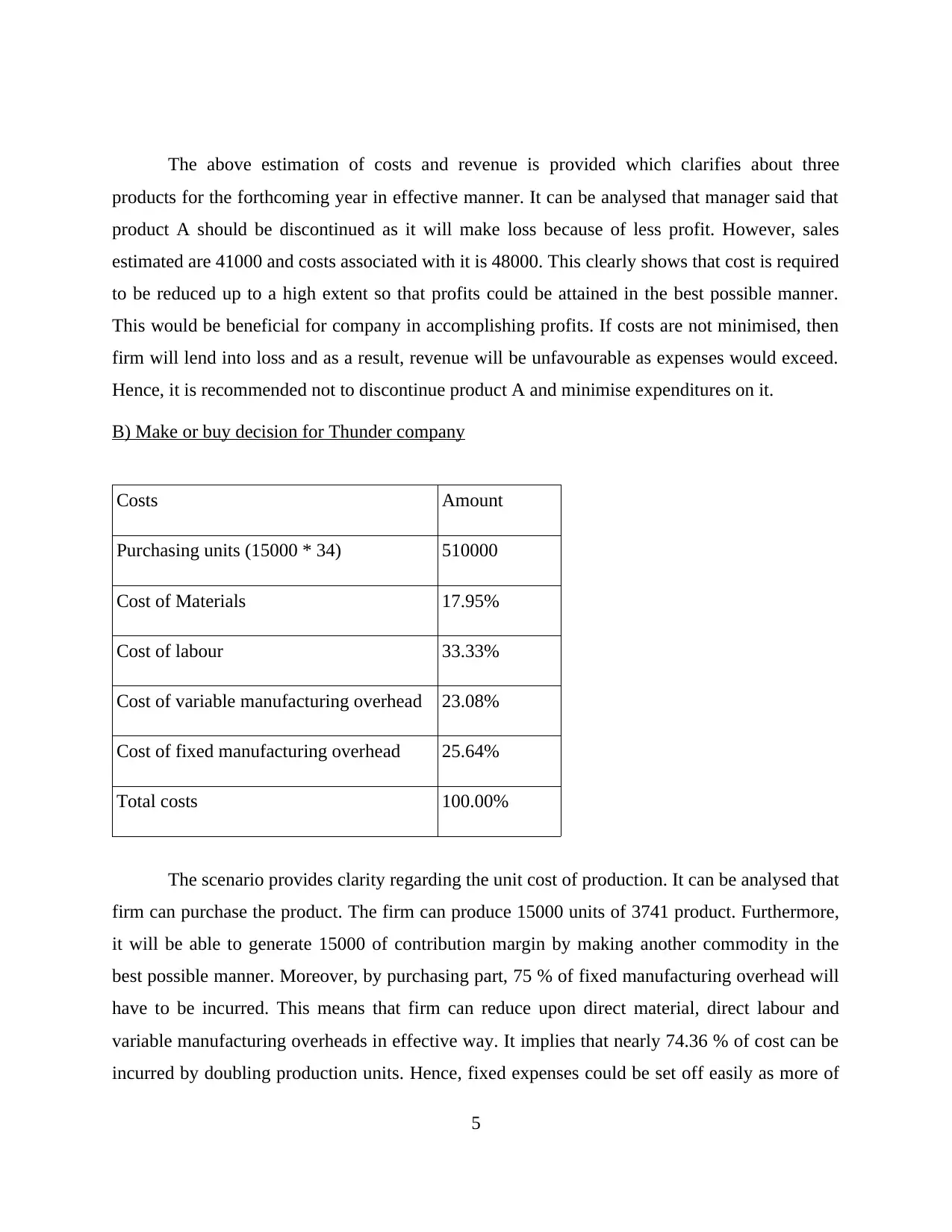
The above estimation of costs and revenue is provided which clarifies about three
products for the forthcoming year in effective manner. It can be analysed that manager said that
product A should be discontinued as it will make loss because of less profit. However, sales
estimated are 41000 and costs associated with it is 48000. This clearly shows that cost is required
to be reduced up to a high extent so that profits could be attained in the best possible manner.
This would be beneficial for company in accomplishing profits. If costs are not minimised, then
firm will lend into loss and as a result, revenue will be unfavourable as expenses would exceed.
Hence, it is recommended not to discontinue product A and minimise expenditures on it.
B) Make or buy decision for Thunder company
Costs Amount
Purchasing units (15000 * 34) 510000
Cost of Materials 17.95%
Cost of labour 33.33%
Cost of variable manufacturing overhead 23.08%
Cost of fixed manufacturing overhead 25.64%
Total costs 100.00%
The scenario provides clarity regarding the unit cost of production. It can be analysed that
firm can purchase the product. The firm can produce 15000 units of 3741 product. Furthermore,
it will be able to generate 15000 of contribution margin by making another commodity in the
best possible manner. Moreover, by purchasing part, 75 % of fixed manufacturing overhead will
have to be incurred. This means that firm can reduce upon direct material, direct labour and
variable manufacturing overheads in effective way. It implies that nearly 74.36 % of cost can be
incurred by doubling production units. Hence, fixed expenses could be set off easily as more of
5
products for the forthcoming year in effective manner. It can be analysed that manager said that
product A should be discontinued as it will make loss because of less profit. However, sales
estimated are 41000 and costs associated with it is 48000. This clearly shows that cost is required
to be reduced up to a high extent so that profits could be attained in the best possible manner.
This would be beneficial for company in accomplishing profits. If costs are not minimised, then
firm will lend into loss and as a result, revenue will be unfavourable as expenses would exceed.
Hence, it is recommended not to discontinue product A and minimise expenditures on it.
B) Make or buy decision for Thunder company
Costs Amount
Purchasing units (15000 * 34) 510000
Cost of Materials 17.95%
Cost of labour 33.33%
Cost of variable manufacturing overhead 23.08%
Cost of fixed manufacturing overhead 25.64%
Total costs 100.00%
The scenario provides clarity regarding the unit cost of production. It can be analysed that
firm can purchase the product. The firm can produce 15000 units of 3741 product. Furthermore,
it will be able to generate 15000 of contribution margin by making another commodity in the
best possible manner. Moreover, by purchasing part, 75 % of fixed manufacturing overhead will
have to be incurred. This means that firm can reduce upon direct material, direct labour and
variable manufacturing overheads in effective way. It implies that nearly 74.36 % of cost can be
incurred by doubling production units. Hence, fixed expenses could be set off easily as more of
5
Paraphrase This Document
Need a fresh take? Get an instant paraphrase of this document with our AI Paraphraser
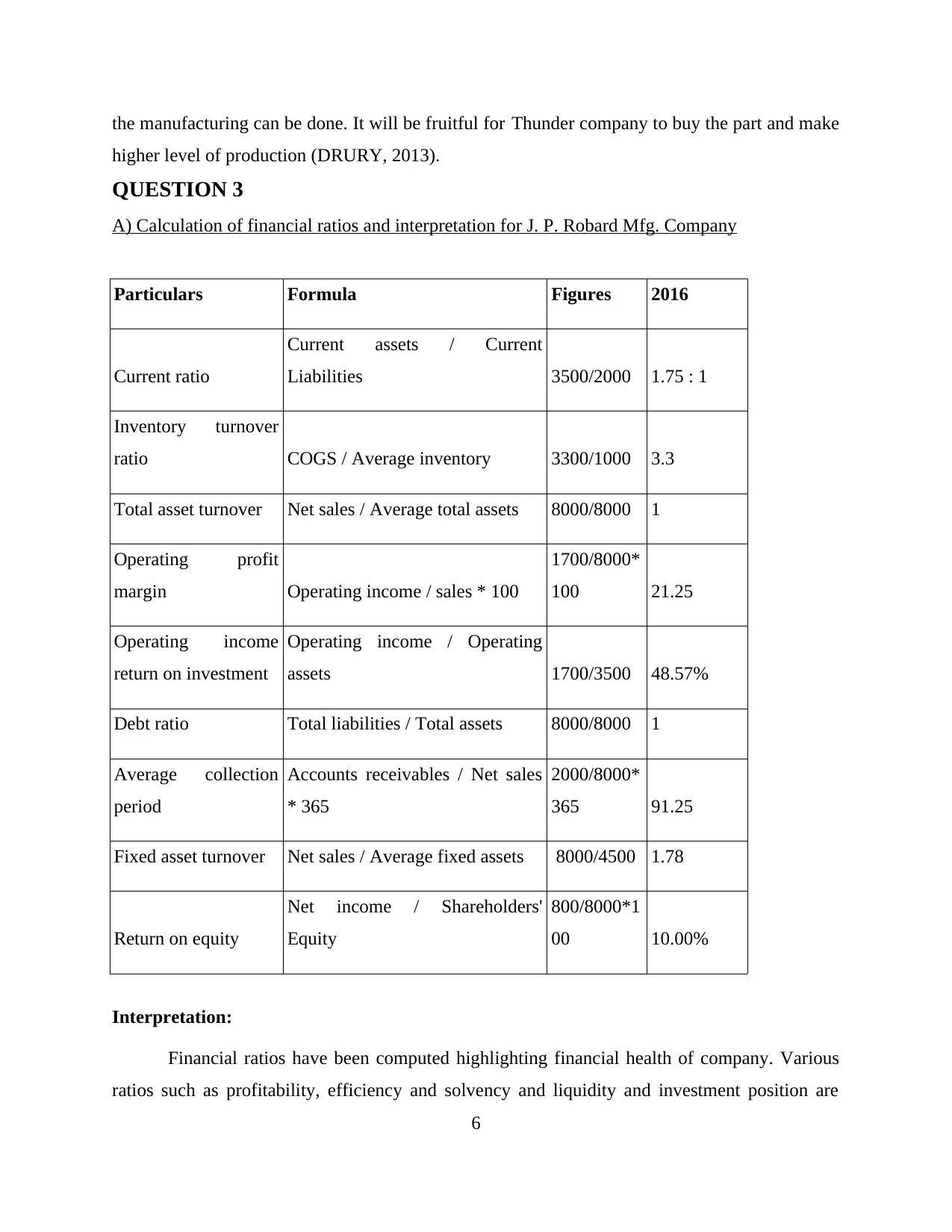
the manufacturing can be done. It will be fruitful for Thunder company to buy the part and make
higher level of production (DRURY, 2013).
QUESTION 3
A) Calculation of financial ratios and interpretation for J. P. Robard Mfg. Company
Particulars Formula Figures 2016
Current ratio
Current assets / Current
Liabilities 3500/2000 1.75 : 1
Inventory turnover
ratio COGS / Average inventory 3300/1000 3.3
Total asset turnover Net sales / Average total assets 8000/8000 1
Operating profit
margin Operating income / sales * 100
1700/8000*
100 21.25
Operating income
return on investment
Operating income / Operating
assets 1700/3500 48.57%
Debt ratio Total liabilities / Total assets 8000/8000 1
Average collection
period
Accounts receivables / Net sales
* 365
2000/8000*
365 91.25
Fixed asset turnover Net sales / Average fixed assets 8000/4500 1.78
Return on equity
Net income / Shareholders'
Equity
800/8000*1
00 10.00%
Interpretation:
Financial ratios have been computed highlighting financial health of company. Various
ratios such as profitability, efficiency and solvency and liquidity and investment position are
6
higher level of production (DRURY, 2013).
QUESTION 3
A) Calculation of financial ratios and interpretation for J. P. Robard Mfg. Company
Particulars Formula Figures 2016
Current ratio
Current assets / Current
Liabilities 3500/2000 1.75 : 1
Inventory turnover
ratio COGS / Average inventory 3300/1000 3.3
Total asset turnover Net sales / Average total assets 8000/8000 1
Operating profit
margin Operating income / sales * 100
1700/8000*
100 21.25
Operating income
return on investment
Operating income / Operating
assets 1700/3500 48.57%
Debt ratio Total liabilities / Total assets 8000/8000 1
Average collection
period
Accounts receivables / Net sales
* 365
2000/8000*
365 91.25
Fixed asset turnover Net sales / Average fixed assets 8000/4500 1.78
Return on equity
Net income / Shareholders'
Equity
800/8000*1
00 10.00%
Interpretation:
Financial ratios have been computed highlighting financial health of company. Various
ratios such as profitability, efficiency and solvency and liquidity and investment position are
6
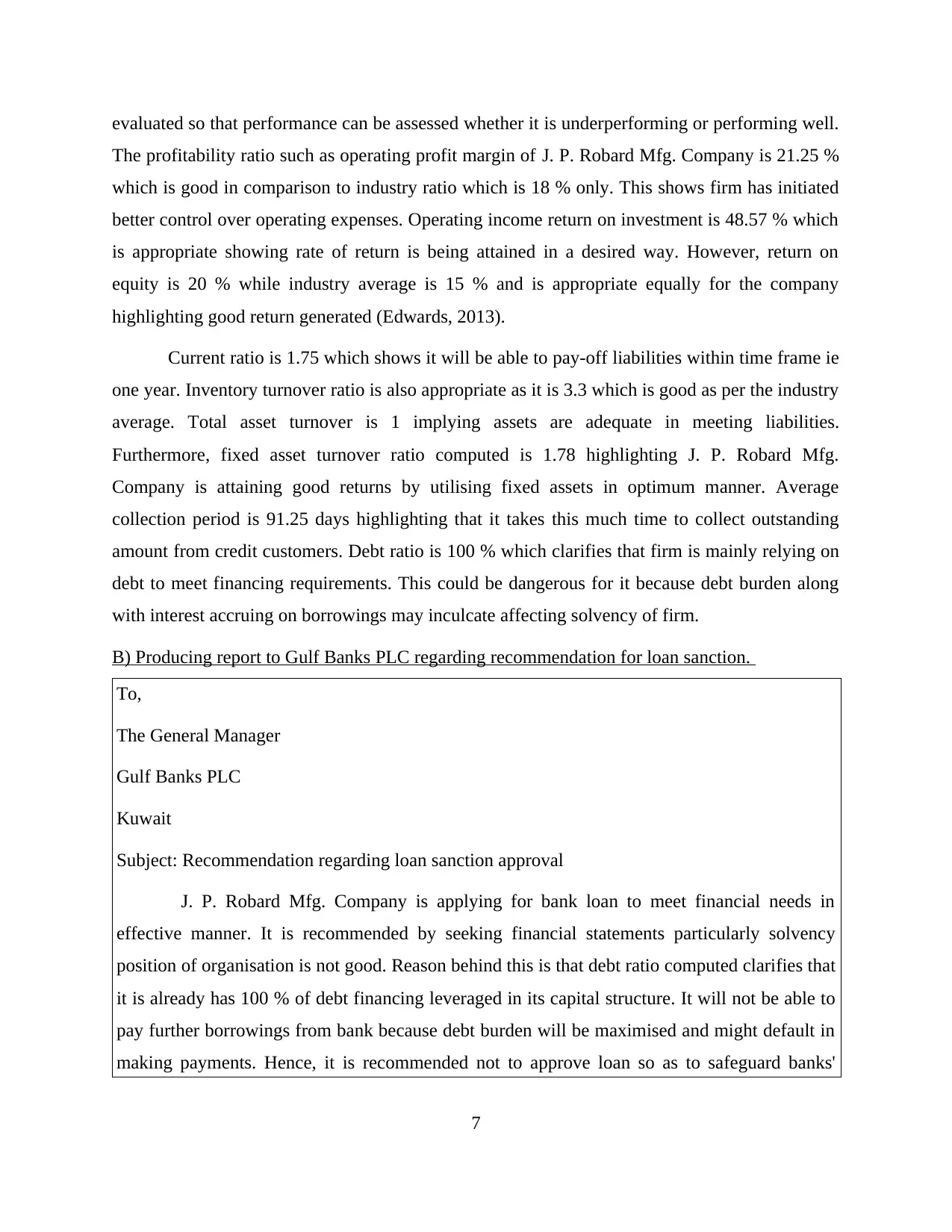
evaluated so that performance can be assessed whether it is underperforming or performing well.
The profitability ratio such as operating profit margin of J. P. Robard Mfg. Company is 21.25 %
which is good in comparison to industry ratio which is 18 % only. This shows firm has initiated
better control over operating expenses. Operating income return on investment is 48.57 % which
is appropriate showing rate of return is being attained in a desired way. However, return on
equity is 20 % while industry average is 15 % and is appropriate equally for the company
highlighting good return generated (Edwards, 2013).
Current ratio is 1.75 which shows it will be able to pay-off liabilities within time frame ie
one year. Inventory turnover ratio is also appropriate as it is 3.3 which is good as per the industry
average. Total asset turnover is 1 implying assets are adequate in meeting liabilities.
Furthermore, fixed asset turnover ratio computed is 1.78 highlighting J. P. Robard Mfg.
Company is attaining good returns by utilising fixed assets in optimum manner. Average
collection period is 91.25 days highlighting that it takes this much time to collect outstanding
amount from credit customers. Debt ratio is 100 % which clarifies that firm is mainly relying on
debt to meet financing requirements. This could be dangerous for it because debt burden along
with interest accruing on borrowings may inculcate affecting solvency of firm.
B) Producing report to Gulf Banks PLC regarding recommendation for loan sanction.
To,
The General Manager
Gulf Banks PLC
Kuwait
Subject: Recommendation regarding loan sanction approval
J. P. Robard Mfg. Company is applying for bank loan to meet financial needs in
effective manner. It is recommended by seeking financial statements particularly solvency
position of organisation is not good. Reason behind this is that debt ratio computed clarifies that
it is already has 100 % of debt financing leveraged in its capital structure. It will not be able to
pay further borrowings from bank because debt burden will be maximised and might default in
making payments. Hence, it is recommended not to approve loan so as to safeguard banks'
7
The profitability ratio such as operating profit margin of J. P. Robard Mfg. Company is 21.25 %
which is good in comparison to industry ratio which is 18 % only. This shows firm has initiated
better control over operating expenses. Operating income return on investment is 48.57 % which
is appropriate showing rate of return is being attained in a desired way. However, return on
equity is 20 % while industry average is 15 % and is appropriate equally for the company
highlighting good return generated (Edwards, 2013).
Current ratio is 1.75 which shows it will be able to pay-off liabilities within time frame ie
one year. Inventory turnover ratio is also appropriate as it is 3.3 which is good as per the industry
average. Total asset turnover is 1 implying assets are adequate in meeting liabilities.
Furthermore, fixed asset turnover ratio computed is 1.78 highlighting J. P. Robard Mfg.
Company is attaining good returns by utilising fixed assets in optimum manner. Average
collection period is 91.25 days highlighting that it takes this much time to collect outstanding
amount from credit customers. Debt ratio is 100 % which clarifies that firm is mainly relying on
debt to meet financing requirements. This could be dangerous for it because debt burden along
with interest accruing on borrowings may inculcate affecting solvency of firm.
B) Producing report to Gulf Banks PLC regarding recommendation for loan sanction.
To,
The General Manager
Gulf Banks PLC
Kuwait
Subject: Recommendation regarding loan sanction approval
J. P. Robard Mfg. Company is applying for bank loan to meet financial needs in
effective manner. It is recommended by seeking financial statements particularly solvency
position of organisation is not good. Reason behind this is that debt ratio computed clarifies that
it is already has 100 % of debt financing leveraged in its capital structure. It will not be able to
pay further borrowings from bank because debt burden will be maximised and might default in
making payments. Hence, it is recommended not to approve loan so as to safeguard banks'
7
⊘ This is a preview!⊘
Do you want full access?
Subscribe today to unlock all pages.

Trusted by 1+ million students worldwide
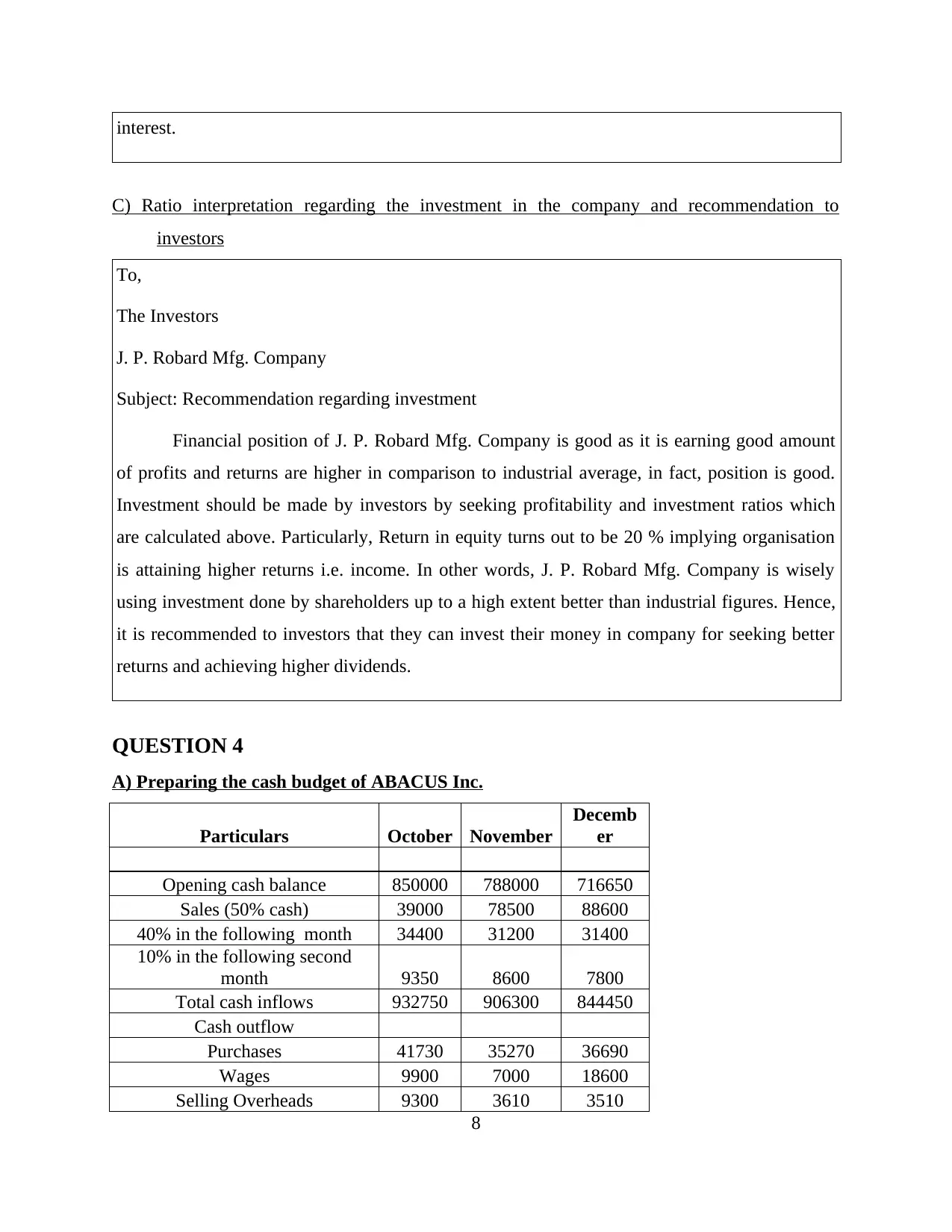
interest.
C) Ratio interpretation regarding the investment in the company and recommendation to
investors
To,
The Investors
J. P. Robard Mfg. Company
Subject: Recommendation regarding investment
Financial position of J. P. Robard Mfg. Company is good as it is earning good amount
of profits and returns are higher in comparison to industrial average, in fact, position is good.
Investment should be made by investors by seeking profitability and investment ratios which
are calculated above. Particularly, Return in equity turns out to be 20 % implying organisation
is attaining higher returns i.e. income. In other words, J. P. Robard Mfg. Company is wisely
using investment done by shareholders up to a high extent better than industrial figures. Hence,
it is recommended to investors that they can invest their money in company for seeking better
returns and achieving higher dividends.
QUESTION 4
A) Preparing the cash budget of ABACUS Inc.
Particulars October November
Decemb
er
Opening cash balance 850000 788000 716650
Sales (50% cash) 39000 78500 88600
40% in the following month 34400 31200 31400
10% in the following second
month 9350 8600 7800
Total cash inflows 932750 906300 844450
Cash outflow
Purchases 41730 35270 36690
Wages 9900 7000 18600
Selling Overheads 9300 3610 3510
8
C) Ratio interpretation regarding the investment in the company and recommendation to
investors
To,
The Investors
J. P. Robard Mfg. Company
Subject: Recommendation regarding investment
Financial position of J. P. Robard Mfg. Company is good as it is earning good amount
of profits and returns are higher in comparison to industrial average, in fact, position is good.
Investment should be made by investors by seeking profitability and investment ratios which
are calculated above. Particularly, Return in equity turns out to be 20 % implying organisation
is attaining higher returns i.e. income. In other words, J. P. Robard Mfg. Company is wisely
using investment done by shareholders up to a high extent better than industrial figures. Hence,
it is recommended to investors that they can invest their money in company for seeking better
returns and achieving higher dividends.
QUESTION 4
A) Preparing the cash budget of ABACUS Inc.
Particulars October November
Decemb
er
Opening cash balance 850000 788000 716650
Sales (50% cash) 39000 78500 88600
40% in the following month 34400 31200 31400
10% in the following second
month 9350 8600 7800
Total cash inflows 932750 906300 844450
Cash outflow
Purchases 41730 35270 36690
Wages 9900 7000 18600
Selling Overheads 9300 3610 3510
8
Paraphrase This Document
Need a fresh take? Get an instant paraphrase of this document with our AI Paraphraser
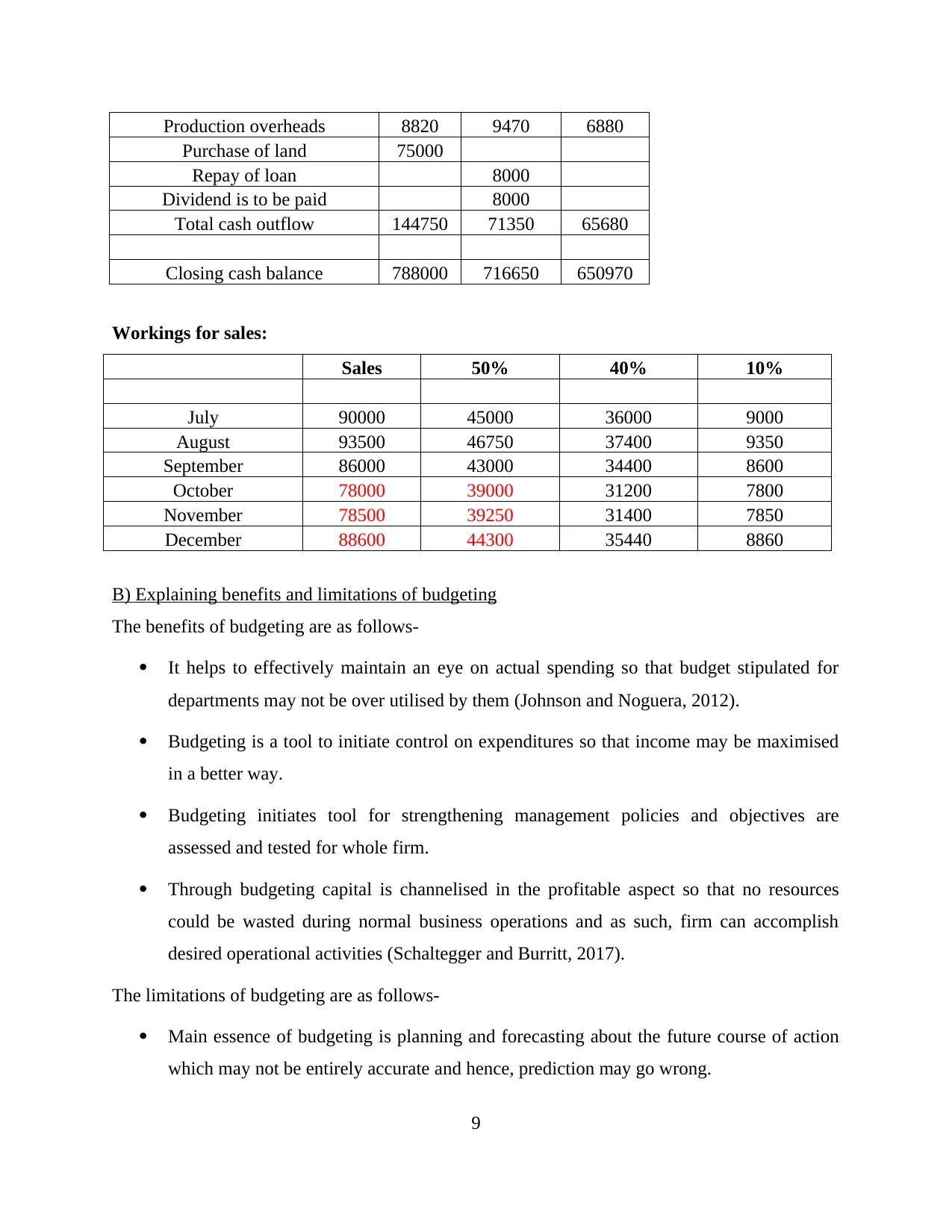
Production overheads 8820 9470 6880
Purchase of land 75000
Repay of loan 8000
Dividend is to be paid 8000
Total cash outflow 144750 71350 65680
Closing cash balance 788000 716650 650970
Workings for sales:
Sales 50% 40% 10%
July 90000 45000 36000 9000
August 93500 46750 37400 9350
September 86000 43000 34400 8600
October 78000 39000 31200 7800
November 78500 39250 31400 7850
December 88600 44300 35440 8860
B) Explaining benefits and limitations of budgeting
The benefits of budgeting are as follows-
It helps to effectively maintain an eye on actual spending so that budget stipulated for
departments may not be over utilised by them (Johnson and Noguera, 2012).
Budgeting is a tool to initiate control on expenditures so that income may be maximised
in a better way.
Budgeting initiates tool for strengthening management policies and objectives are
assessed and tested for whole firm.
Through budgeting capital is channelised in the profitable aspect so that no resources
could be wasted during normal business operations and as such, firm can accomplish
desired operational activities (Schaltegger and Burritt, 2017).
The limitations of budgeting are as follows-
Main essence of budgeting is planning and forecasting about the future course of action
which may not be entirely accurate and hence, prediction may go wrong.
9
Purchase of land 75000
Repay of loan 8000
Dividend is to be paid 8000
Total cash outflow 144750 71350 65680
Closing cash balance 788000 716650 650970
Workings for sales:
Sales 50% 40% 10%
July 90000 45000 36000 9000
August 93500 46750 37400 9350
September 86000 43000 34400 8600
October 78000 39000 31200 7800
November 78500 39250 31400 7850
December 88600 44300 35440 8860
B) Explaining benefits and limitations of budgeting
The benefits of budgeting are as follows-
It helps to effectively maintain an eye on actual spending so that budget stipulated for
departments may not be over utilised by them (Johnson and Noguera, 2012).
Budgeting is a tool to initiate control on expenditures so that income may be maximised
in a better way.
Budgeting initiates tool for strengthening management policies and objectives are
assessed and tested for whole firm.
Through budgeting capital is channelised in the profitable aspect so that no resources
could be wasted during normal business operations and as such, firm can accomplish
desired operational activities (Schaltegger and Burritt, 2017).
The limitations of budgeting are as follows-
Main essence of budgeting is planning and forecasting about the future course of action
which may not be entirely accurate and hence, prediction may go wrong.
9
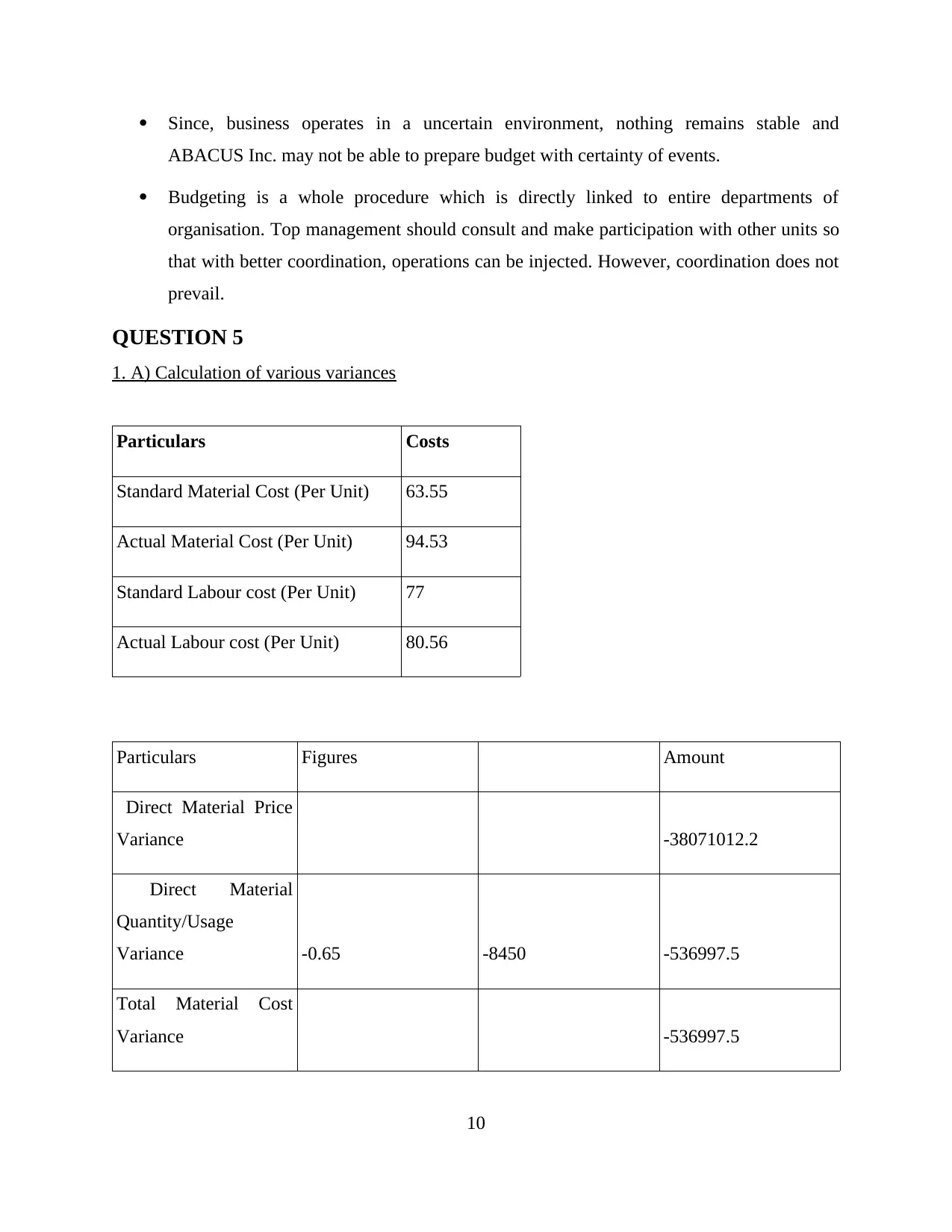
Since, business operates in a uncertain environment, nothing remains stable and
ABACUS Inc. may not be able to prepare budget with certainty of events.
Budgeting is a whole procedure which is directly linked to entire departments of
organisation. Top management should consult and make participation with other units so
that with better coordination, operations can be injected. However, coordination does not
prevail.
QUESTION 5
1. A) Calculation of various variances
Particulars Costs
Standard Material Cost (Per Unit) 63.55
Actual Material Cost (Per Unit) 94.53
Standard Labour cost (Per Unit) 77
Actual Labour cost (Per Unit) 80.56
Particulars Figures Amount
Direct Material Price
Variance -38071012.2
Direct Material
Quantity/Usage
Variance -0.65 -8450 -536997.5
Total Material Cost
Variance -536997.5
10
ABACUS Inc. may not be able to prepare budget with certainty of events.
Budgeting is a whole procedure which is directly linked to entire departments of
organisation. Top management should consult and make participation with other units so
that with better coordination, operations can be injected. However, coordination does not
prevail.
QUESTION 5
1. A) Calculation of various variances
Particulars Costs
Standard Material Cost (Per Unit) 63.55
Actual Material Cost (Per Unit) 94.53
Standard Labour cost (Per Unit) 77
Actual Labour cost (Per Unit) 80.56
Particulars Figures Amount
Direct Material Price
Variance -38071012.2
Direct Material
Quantity/Usage
Variance -0.65 -8450 -536997.5
Total Material Cost
Variance -536997.5
10
⊘ This is a preview!⊘
Do you want full access?
Subscribe today to unlock all pages.

Trusted by 1+ million students worldwide
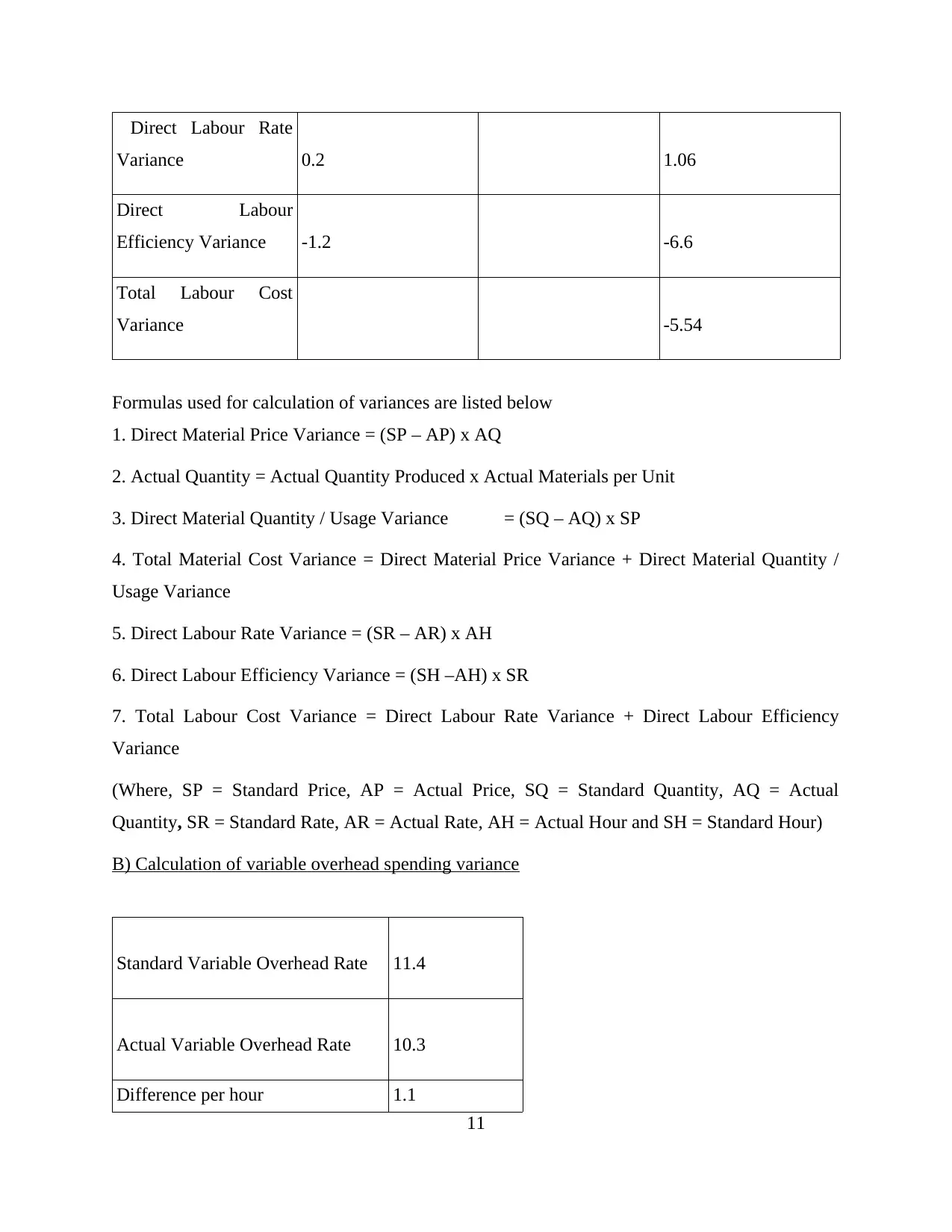
Direct Labour Rate
Variance 0.2 1.06
Direct Labour
Efficiency Variance -1.2 -6.6
Total Labour Cost
Variance -5.54
Formulas used for calculation of variances are listed below
1. Direct Material Price Variance = (SP – AP) x AQ
2. Actual Quantity = Actual Quantity Produced x Actual Materials per Unit
3. Direct Material Quantity / Usage Variance = (SQ – AQ) x SP
4. Total Material Cost Variance = Direct Material Price Variance + Direct Material Quantity /
Usage Variance
5. Direct Labour Rate Variance = (SR – AR) x AH
6. Direct Labour Efficiency Variance = (SH –AH) x SR
7. Total Labour Cost Variance = Direct Labour Rate Variance + Direct Labour Efficiency
Variance
(Where, SP = Standard Price, AP = Actual Price, SQ = Standard Quantity, AQ = Actual
Quantity, SR = Standard Rate, AR = Actual Rate, AH = Actual Hour and SH = Standard Hour)
B) Calculation of variable overhead spending variance
Standard Variable Overhead Rate 11.4
Actual Variable Overhead Rate 10.3
Difference per hour 1.1
11
Variance 0.2 1.06
Direct Labour
Efficiency Variance -1.2 -6.6
Total Labour Cost
Variance -5.54
Formulas used for calculation of variances are listed below
1. Direct Material Price Variance = (SP – AP) x AQ
2. Actual Quantity = Actual Quantity Produced x Actual Materials per Unit
3. Direct Material Quantity / Usage Variance = (SQ – AQ) x SP
4. Total Material Cost Variance = Direct Material Price Variance + Direct Material Quantity /
Usage Variance
5. Direct Labour Rate Variance = (SR – AR) x AH
6. Direct Labour Efficiency Variance = (SH –AH) x SR
7. Total Labour Cost Variance = Direct Labour Rate Variance + Direct Labour Efficiency
Variance
(Where, SP = Standard Price, AP = Actual Price, SQ = Standard Quantity, AQ = Actual
Quantity, SR = Standard Rate, AR = Actual Rate, AH = Actual Hour and SH = Standard Hour)
B) Calculation of variable overhead spending variance
Standard Variable Overhead Rate 11.4
Actual Variable Overhead Rate 10.3
Difference per hour 1.1
11
Paraphrase This Document
Need a fresh take? Get an instant paraphrase of this document with our AI Paraphraser

Actual Labour Hours 360
Variable Overhead Spending
Variance 396
It can be analysed from the above calculated Variable Overhead Spending Variance that
it is favourable because standard rate is much more than actual overhead spending and as such,
value attained is positive. Hence, positive Variable Overhead Spending Variance is favourable in
this context.
C) Computation of variable overhead efficiency variance
Actual Units Manufactured 720
Standard Direct Labour Hours Per
Unit 1.2
Standard Direct Labour hours Allowed 864
Standard Direct Labour 864
Less: Actual Hours utilised 360
Difference 504
Standard overhead rate 11.4
Variable overhead efficiency variance 5745.6
The Variable overhead efficiency variance is used to effectively measure the productivity
and efficiency of department of production or manufacturing to analyse ability to quickly convert
12
Variable Overhead Spending
Variance 396
It can be analysed from the above calculated Variable Overhead Spending Variance that
it is favourable because standard rate is much more than actual overhead spending and as such,
value attained is positive. Hence, positive Variable Overhead Spending Variance is favourable in
this context.
C) Computation of variable overhead efficiency variance
Actual Units Manufactured 720
Standard Direct Labour Hours Per
Unit 1.2
Standard Direct Labour hours Allowed 864
Standard Direct Labour 864
Less: Actual Hours utilised 360
Difference 504
Standard overhead rate 11.4
Variable overhead efficiency variance 5745.6
The Variable overhead efficiency variance is used to effectively measure the productivity
and efficiency of department of production or manufacturing to analyse ability to quickly convert
12
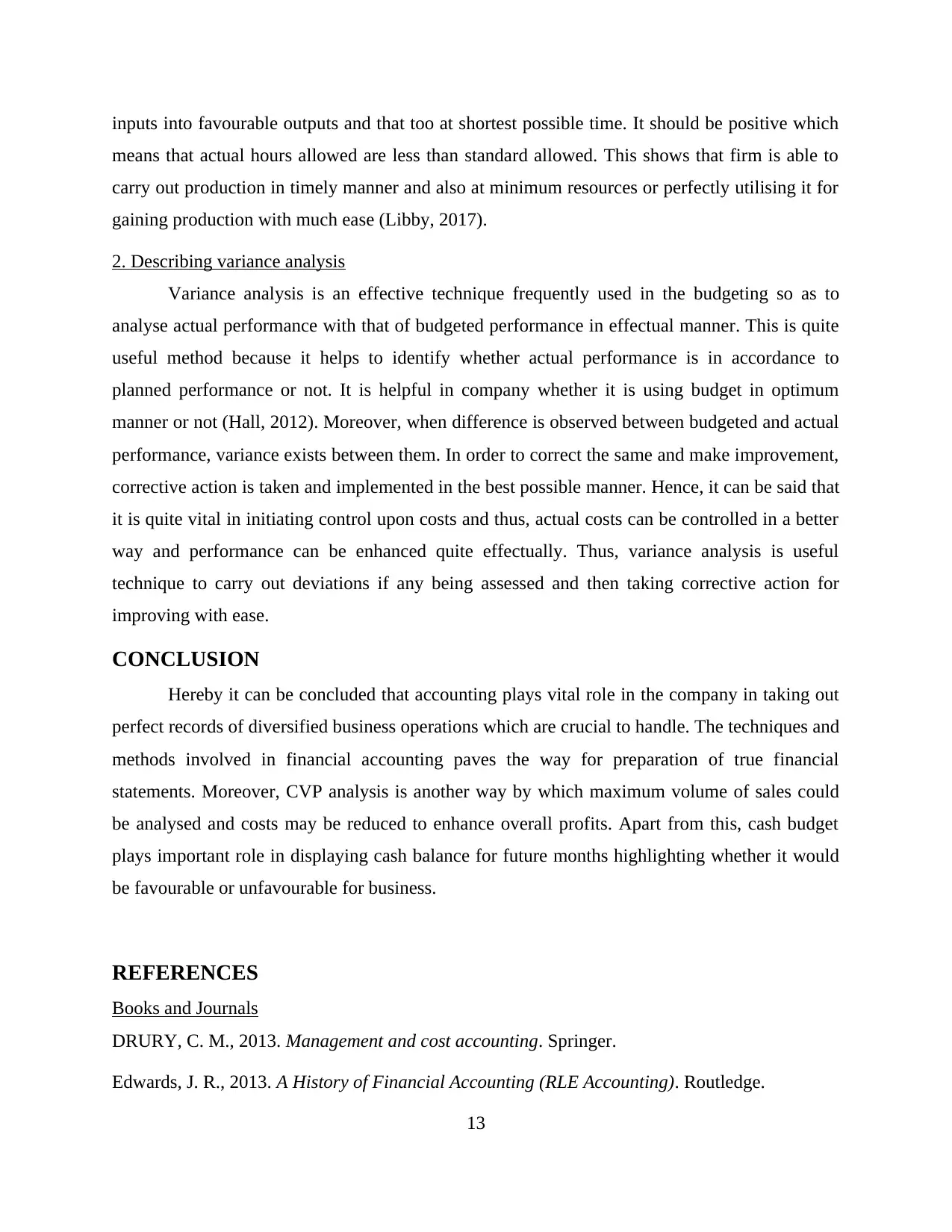
inputs into favourable outputs and that too at shortest possible time. It should be positive which
means that actual hours allowed are less than standard allowed. This shows that firm is able to
carry out production in timely manner and also at minimum resources or perfectly utilising it for
gaining production with much ease (Libby, 2017).
2. Describing variance analysis
Variance analysis is an effective technique frequently used in the budgeting so as to
analyse actual performance with that of budgeted performance in effectual manner. This is quite
useful method because it helps to identify whether actual performance is in accordance to
planned performance or not. It is helpful in company whether it is using budget in optimum
manner or not (Hall, 2012). Moreover, when difference is observed between budgeted and actual
performance, variance exists between them. In order to correct the same and make improvement,
corrective action is taken and implemented in the best possible manner. Hence, it can be said that
it is quite vital in initiating control upon costs and thus, actual costs can be controlled in a better
way and performance can be enhanced quite effectually. Thus, variance analysis is useful
technique to carry out deviations if any being assessed and then taking corrective action for
improving with ease.
CONCLUSION
Hereby it can be concluded that accounting plays vital role in the company in taking out
perfect records of diversified business operations which are crucial to handle. The techniques and
methods involved in financial accounting paves the way for preparation of true financial
statements. Moreover, CVP analysis is another way by which maximum volume of sales could
be analysed and costs may be reduced to enhance overall profits. Apart from this, cash budget
plays important role in displaying cash balance for future months highlighting whether it would
be favourable or unfavourable for business.
REFERENCES
Books and Journals
DRURY, C. M., 2013. Management and cost accounting. Springer.
Edwards, J. R., 2013. A History of Financial Accounting (RLE Accounting). Routledge.
13
means that actual hours allowed are less than standard allowed. This shows that firm is able to
carry out production in timely manner and also at minimum resources or perfectly utilising it for
gaining production with much ease (Libby, 2017).
2. Describing variance analysis
Variance analysis is an effective technique frequently used in the budgeting so as to
analyse actual performance with that of budgeted performance in effectual manner. This is quite
useful method because it helps to identify whether actual performance is in accordance to
planned performance or not. It is helpful in company whether it is using budget in optimum
manner or not (Hall, 2012). Moreover, when difference is observed between budgeted and actual
performance, variance exists between them. In order to correct the same and make improvement,
corrective action is taken and implemented in the best possible manner. Hence, it can be said that
it is quite vital in initiating control upon costs and thus, actual costs can be controlled in a better
way and performance can be enhanced quite effectually. Thus, variance analysis is useful
technique to carry out deviations if any being assessed and then taking corrective action for
improving with ease.
CONCLUSION
Hereby it can be concluded that accounting plays vital role in the company in taking out
perfect records of diversified business operations which are crucial to handle. The techniques and
methods involved in financial accounting paves the way for preparation of true financial
statements. Moreover, CVP analysis is another way by which maximum volume of sales could
be analysed and costs may be reduced to enhance overall profits. Apart from this, cash budget
plays important role in displaying cash balance for future months highlighting whether it would
be favourable or unfavourable for business.
REFERENCES
Books and Journals
DRURY, C. M., 2013. Management and cost accounting. Springer.
Edwards, J. R., 2013. A History of Financial Accounting (RLE Accounting). Routledge.
13
⊘ This is a preview!⊘
Do you want full access?
Subscribe today to unlock all pages.

Trusted by 1+ million students worldwide
1 out of 15
Related Documents
Your All-in-One AI-Powered Toolkit for Academic Success.
+13062052269
info@desklib.com
Available 24*7 on WhatsApp / Email
![[object Object]](/_next/static/media/star-bottom.7253800d.svg)
Unlock your academic potential
© 2024 | Zucol Services PVT LTD | All rights reserved.





